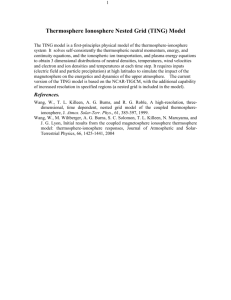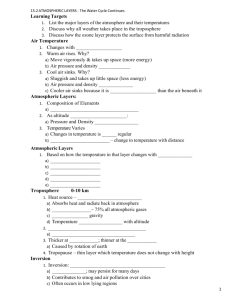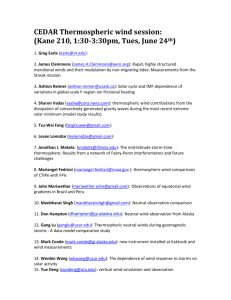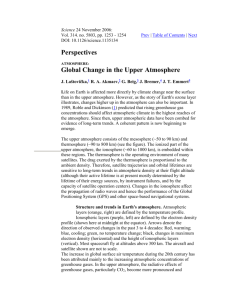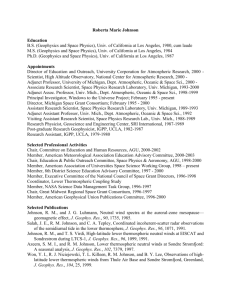Doc - WMO
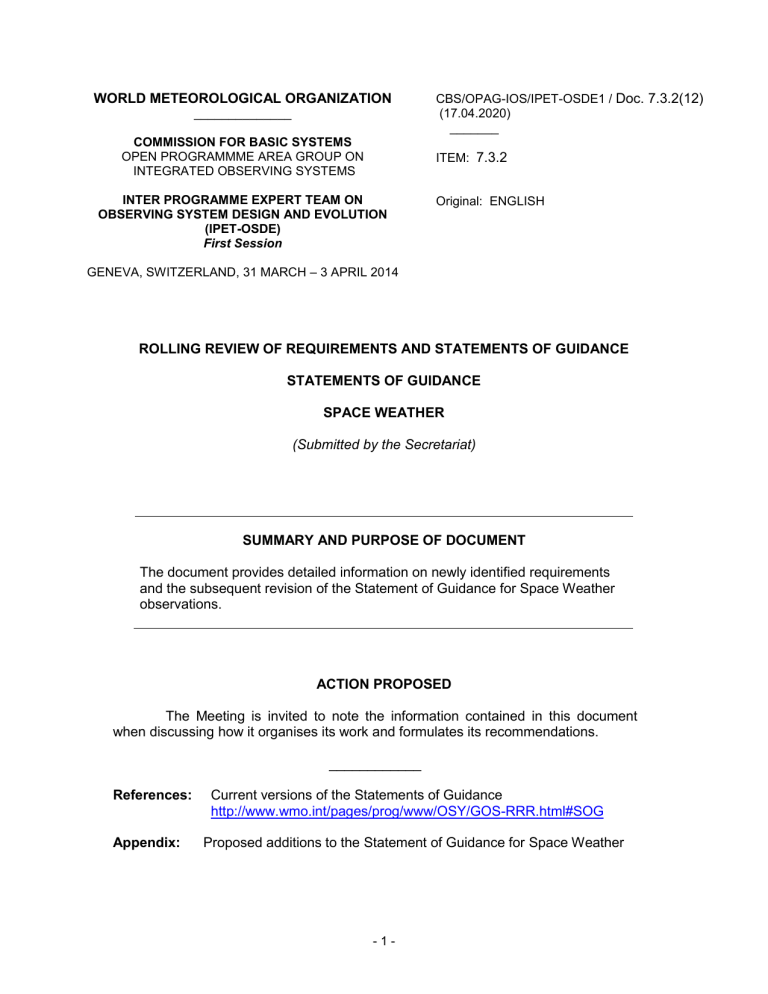
WORLD METEOROLOGICAL ORGANIZATION
______________
COMMISSION FOR BASIC SYSTEMS
OPEN PROGRAMMME AREA GROUP ON
INTEGRATED OBSERVING SYSTEMS
INTER PROGRAMME EXPERT TEAM ON
OBSERVING SYSTEM DESIGN AND EVOLUTION
(IPET-OSDE)
First Session
GENEVA, SWITZERLAND, 31 MARCH – 3 APRIL 2014
CBS/OPAG-IOS/IPET-OSDE1 / Doc. 7.3.2(12)
(17.04.2020)
_______
ITEM: 7.3.2
Original: ENGLISH
ROLLING REVIEW OF REQUIREMENTS AND STATEMENTS OF GUIDANCE
STATEMENTS OF GUIDANCE
SPACE WEATHER
(Submitted by the Secretariat)
SUMMARY AND PURPOSE OF DOCUMENT
The document provides detailed information on newly identified requirements and the subsequent revision of the Statement of Guidance for Space Weather observations.
ACTION PROPOSED
The Meeting is invited to note the information contained in this document when discussing how it organises its work and formulates its recommendations.
____________
References: Current versions of the Statements of Guidance http://www.wmo.int/pages/prog/www/OSY/GOS-RRR.html#SOG
Appendix: Proposed additions to the Statement of Guidance for Space Weather
- 1 -
CBS/OPAG-IOS/IPET-OSDE1/Doc. 7.3.2(12)
DISCUSSION
1. New requirements
In the past year, new observation requirements have been identified by the Inter-
Programme Coordination Team on Space Weather (ICTSW). These are:
Radiation Dose Rate at airline cruising altitude
Temperature, horizontal wind and atmospheric density for the lower thermosphere (100-200 km) and the upper thermosphere (200 km to about 600 km).
Variable
Layer(s) Uncertainty Hor.Res. Ver.Res.
Observing
Cycle Timeliness
Atmospheric temperature
HiThermo 35 K 100 km 20 km 5 sec 30 min
Atmospheric temperature
Wind (horizontal)
LoThermo
HiThermo
75 K
140 K
10 K
14 K
20 K
200 km
500 km
100 km
200 km
500 km
10 m.s
-1 100 km
30 km
50 km
5 km
10 km
25 km
20 km
5 min
30 min
5 sec
1 min
5 min
5 sec
30 min
60 min
5 min
5 min
60 min
30 min
Wind (horizontal)
LoThermo
20 m.s
-1 200 km
30 m.s
-1 500 km
5 m.s
-1 100 km
7 m.s
-1 200 km
30 km
50 km
5 km
10 km
5 min
30 min
5 sec
1 min
30 min
60 min
5 min
5 min
Atmospheric density HiThermo
10 m.s
-1 500 km
10 % 100 km
15 % 200 km
25 km
20 km
50 km
5 min
5 sec
5 min
60 min
30 min
30 min
20 % 500 km 100 km 30 min 60 min
Atmospheric density
Radiation Dose Rate
LoThermo
LS
5 %
7 %
10 %
5 %
10 %
20 %
100 km
200 km
500 km
100 km
200 km
500 km
5 km
10 km
25 km
0.1 km
1 km
2 km
5 sec
1 min
5 min
1min
5 min
10 min
5 min
5 min
60 min
5 min
5 min
20min
2. Review of space weather variables
A systematic review of the definition and names of the space weather variables was undertaken and is still in progress. Among the issues which are addressed, the ICTSW is reviewing for instance the terms used to characterize particle fluxes (directional or angular flux versus integrated flux, flux density energy spectrum versus differential flux,
- 2 -
CBS/OPAG-IOS/IPET-OSDE1/Doc. 7.3.2(12)
etc) with the aim to conciliate scientific correctness, community agreed practices, and
OSCAR template constraints.
3. Proposed additions to the Statement of guidance
As a consequence of the addition of new requirements, new material has been developed by David Jackson (United Kingdom) for the Statement of Guidance (SOG) which reviews capabilities and shortcomings in the provision of the newly required observations. (See Appendix).
The fourth session of ICTSW approved this text and considered it was very comprehensive. It was however agreed to include only a summary of it in the revised
SOG in order to respect the overall balance of the text without overemphasizing the importance of the new observations.
4. Conclusion
The IPET-OSDE is invited to note the new requirements and to provide guidance regarding the revision of the SOG.
_______________
- 3 -
CBS/OPAG-IOS/IPET-OSDE1/Doc. 7.3.2(12)
APPENDIX
PROPOSED ADDITIONS TO THE STATEMENT OF GUIDANCE FOR SPACE WEATHER
NOTE
The proposed additions are to Section 3 of the Statement of Guidance document at http://www.wmo.int/pages/prog/www/OSY/SOG/SoG-SW.doc
and the Section and subsection titles and numbering follow the same format. Once the text below is accepted, other changes to the main Statement of Guidance document can be made (eg updating the list of recommendations in Section 1 in that document)
ACKNOWLEDGEMENTS
The following provided useful comments: Anasuya Aruliah, Sean Bruinsma, Eelco
Doornbos, Clive Dyer, John Emmert and Keith Ryden.
STATEMENT OF GUIDANCE FOR SPACE WEATHER OBSERVATIONS
3. Space Weather observational domains
3.1 Radiation Dose Rate Observations
3.1.1 Requirements
The requirement is to obtain radiation dose rate measurements at airline cruising altitude
- approximately 20,000 ft to 50,000 ft. The threshold value for data availability
(timeliness) is 30 min and the goal value is 5 min. Observations should be made with a cycle of 60 sec (goal) to 10 min (threshold). Uncertainty in the observations ranges from
5% (goal) to 50% (threshold). Desired resolutions are 100km (goal) to 500 km
(threshold) in the horizontal, and 0.1 km (goal) to 1 km (threshold) in the vertical.
A positive impact is expected from these observations, but this is not yet validated due to a lack of suitable data available operationally.
One aim of this Statement of Guidance is to trigger actions for enabling many more radiation monitors to be in operational use.
3.1.2 Radiation Dose Rate monitoring techniques
The only way to routinely monitor radiation dose rates at aviation flight level is via dosimeters that are carried on board aircraft or, potentially, on persistent high altitude platforms such as UAVs. Tissue Equivalent Proportional Counters (TEPCs) are the formal dosimetry standard and such instruments e.g. the HAWK (FWT) are already available for carrying on aircraft. Unfortunately the mass of a TEPC is about 5kg (10kg including carrying case) which can be unattractive for routine commercial flying: in addition TEPCs use a sealed (propane) gas vessel and may include a small radioactive source, both of which can lead to complications when seeking for approvals to fly.
The alternative instrument is the compact solid-state dosimeter which has been gradually evolving over the past 30 years. Starting in the late 1980s Dyer et al (1989) developed the solid state Cosmic Radiation Environment and Activation Monitor
- 4 -
CBS/OPAG-IOS/IPET-OSDE1/Doc. 7.3.2(12)
(CREAM) which was flown extensively on Concorde , the Space Shuttle, MIR Space
Station and numerous aircraft (Dyer, 2000 and 2005) and other workers have deployed devices based on similar principles (e.g. Dachev, 2002). Current more compact manifestations of the CREAM solid-state dosimeter (Dyer, 2009] have a mass in the region of several hundred grams for the active elements, although (where required) batteries can push total mass above 1kg. As well as providing the dose rate and neutron flux, solid state detectors have the advantage that the underlying chargedeposition spectra are of direct importance for understanding single event effects in aircraft avionics (which was in fact the original reason for their development).
Standard commercial dosimeters such as electronic personal dosimeters (EPDs) as used in the nuclear industry have been occasionally flown but will not generally give accurate readings since they are sensitive to only restricted elements of the atmospheric radiation field. Even if cross-calibrated for one set of atmospheric conditions (altitudes, latitudes, solar conditions), they are unlikely to maintain accuracy in other conditions since the relative contributions of different particles change.
Of vital importance for any dose-rate instrument is the need for the demonstration of reliable cross-calibration against TEPCs in flight conditions over a wide range of altitudes and latitudes. Similar cross-calibrations in ground reference fields e.g. the
CERF facility at CERN are also highly desirable.
3.1.3 Current Status
To date only a relatively small number of dose-rate instruments have been deployed on aircraft, usually on an ad-hoc basis for research purposes and their geographic coverage has been sparse and un-coordinated. In recent years compact CREAM-type dosimeters have been flown (alongside TEPCs for cross-calibration) over a wide range of latitudes and altitudes (extending up to 49000 feet) as employed by executive jets (Dyer et al,
2009). . The present generation monitor is housed in a box measuring 260 x 107 x 57 mm and weighs 1.16 kg (this is a factor 4 lower in mass and volume compared with the
TEPCs). An even more miniaturised instrument is being developed with a target mass of less than 250g excluding batteries (since often an aircraft on-board supply will be available).. Such a dosimeter has advantages in terms of ruggedness and portability and would be suitable for wide deployment. The energy depositions in the range 0.1 to 100
MeV are analysed into 15 channels with time collection periods currently set to 2 minutes. This current generation of CREAM-type monitors were deployed on executive jets from October 2007 with a number of flights between UK and India and China. From
August 2008 to 2009 there were 33 flights on a Boeing-747 on routes from London to
Sydney, Australia via Singapore or Hong Kong, plus high-latitude, southern-hemisphere flights between Australia (Sydney and Melbourne) and Johannesburg, South Africa and
Buenos Aires, Argentina. Some 17 of these flights have had accompanying HAWK2
TEPCs and other monitors. Further flights, predominantly transpolar, based on Hong
Kong and Canada commenced in June 2009. On the Boeing-747 flights, the monitors have been operated in the cockpit. Hence the aircraft shielding is deemed to be minimal in such cases so that doses are close to worst case and to those levels given by the codes for free air.
The calibrated data from these dosimeters agreed well with TEPCs across a wide range of latitudes and altitudes. Systematic errors are less than about 5%. For flight measurements summed over 20 minute time intervals the statistical errors are around
- 5 -
CBS/OPAG-IOS/IPET-OSDE1/Doc. 7.3.2(12)
10%, and for the accumulated route doses statistical errors are reduced to about
2%.For executive jet flights the cruising altitudes are higher compared with normal passenger routes and hence are more exposed to radiation. In these flights the TEPC employed was the older HAWK1 version and the TEPC data are slightly higher than the calibrated data. This is possibly representative of the level of agreement attainable between TEPCs as the dosimeter units were identical.
Based on the evidence presented above, compact solid-state dosimeter observations can meet the threshold requirements for observation uncertainty. Observation cycle is between the goal and threshold values, though there is a trade-off between reduced uncertainly and a poorer observational cycle. Data timeliness is better than the goal, and vertical resolution is close to the goal. The threshold and goal requirements for horizontal resolution will only be met when the instruments are widely deployed on commercial airliners, which is not the case at present. A compact solid state dosimeter is currently deployed on the MOCCA UK research aircraft and routinely on an A380 aircraft. Indeed a few airlines do carry dosimeters from time-to-time when provided by research projects, but data access is thus limited. Geographical and temporal coverage and data availability could be significantly improved by mounting the instruments routinely on commercial airliners and disseminating observations via AMDAR.
3.1.4 Conclusions and Recommendations
Properly calibrated, compact solid-state radiation dosimeters can meet most of the WMO observational requirements. They will prove to be very useful for producing real time radiation nowcasts for aviation users in the future, and play a key part in the development of radiation forecast models. However, they need to be deployed widely on commercial airliners before the requirements for horizontal resolution can be met and before the abovementioned nowcast and forecast services can ever hope to be realized.
Discussion with ICAO is underway which will lead to the finalization of a Concept of
Operations for space weather services for aviation. Radiation alerts are an important part of this ConOps. Its publication should provide an impetus for the greater introduction of in flight radiation monitors
Recommendations:
Efforts should be made to install radiation monitors on aircraft. The UK Royal
Academy of Engineering (Cannon et al, 2013) has recommended that all aircraft operating above a certain altitude (25000-35000 feet) should carry a radiation sensor and logger.
An examination should be made of the most effective means of disseminating on-board radiation monitor observations in near real time (eg using AMDAR), with a view to a potential trial/demonstration.
3.2 Thermospheric Observations
3.2.1 Requirements
- 6 -
CBS/OPAG-IOS/IPET-OSDE1/Doc. 7.3.2(12)
Observations of temperature, atmospheric density and horizontal wind are required throughout the thermosphere to produce space weather alerts (eg of satellite drag).
Observations requirements differ between the lower thermosphere (100-200 km altitude) and the upper thermosphere (200 to around 600 km altitude). The WMO observations requirements are as follows:
Lower thermospheric observations (100-200 km altitude)
For all lower thermospheric observations the threshold value for data availability
(timeliness) is 60 min and the goal value is 5 min. Observations should be made with a cycle of 5 sec (goal) to 5 min (threshold). Desired resolutions are 100km (goal) to 500 km (threshold) in the horizontal and 5 km (goal) to 25 km (threshold) in the vertical.
Uncertainty in the observations should range from 10 K (goal) to 20 K (threshold) for
Temperature , 5 % (goal) to 10 % (threshold) for Atmospheric Density , and from 5m/s
(goal) to 10 m/s (threshold) for Horizontal Wind
Upper thermospheric observations (200 km to about 600 km altitude)
For all upper thermospheric observations the threshold value for data availability
(timeliness) is 60 min and the goal value is 30 min. Observations should be made with a cycle of 5 sec (goal) to 30 min (threshold). Desired horizontal resolutions are 100km
(goal) to 500 km (threshold).
Uncertainty in the Temperature observations ranges from 35 K (goal) to 140 K
(threshold). (Note that in percentage terms, the uncertainties range from 5% (goal) to
10% (threshold), and that typical temperatures may double from solar minimum to solar maximum. The quoted temperature uncertainties correspond to 5% uncertainty for solar minimum (goal) to 10% uncertainty for solar maximum (threshold) in order to cover the largest range). Uncertainty in the observations ranges from 10 m/s (goal) to 30 m/s
(threshold) for Horizontal Wind and 10 % (goal) to 20 % (threshold) for Atmospheric
Density.
Desired vertical resolutions are 20 km (goal) to 50 km (threshold) for Temperature and
Horizontal Wind and 20 km (goal) to 100 km (threshold) for Atmospheric Density
3.2.2 Thermosphere monitoring techniques
The thermosphere is chiefly observed using satellites. They typically have global coverage but in many cases observe over a restricted vertical range or have coarse vertical resolution. Ground-based observations from Fabry-Perot Interferometers (FPIs) can produce high-quality, timely observations, but with limited horizontal resolution since they are based on observations from a selection of sites. There are also issues with limited vertical coverage since they are dependent on the heights of the airglow and auroral emission layers. Radar observations are also available, but in the height range of interest they tend to observe the ionised atmosphere (eg ion temperature, electron density) rather than the neutral atmospheric variables we are interested in here
(although these neutral atmospheric variables can be inferred from the ionised atmosphere observations). Radars also observe temperature and horizontal wind, but typically below 100 km. Rocket observations (eg Clemmons et al, 2008) have better vertical resolution but share issues of horizontal coverage with the ground based
- 7 -
CBS/OPAG-IOS/IPET-OSDE1/Doc. 7.3.2(12)
observations, and are made less frequently. They are also launched infrequently due to their high cost. There are also a few ground-based lidar observations available which provide temperature and wind measurements up to 105 km in altitude (e.g. She et al,
2009).
Thermospheric Temperature
.
The basic techniques for temperature measurements in the lower thermosphere have been demonstrated by many previous satellites, and focus on emission from the diatomic oxygen atmospheric band (A-band). Highly resolved spectral images of these emissions can be used to determine temperatures at the location of the emission.
FPIs have been used for many years to measure upper thermospheric temperatures by observing the atomic oxygen 630 nm red line emission and fitting calculated spectra to determine the thermal broadening from the recorded emission profiles. Observations are limited to nighttime and clear sky conditions at present..
Lower thermospheric temperature can also be observed by rockets. For example, the
HEX-2 Sounding Rocket Investigation sampled the thermosphere using four sounding rockets from Poker Flat, Alaska over a range of latitudes, longitudes and altitudes in
February 2007. However, while rockets do explore the whole lower thermosphere, the time spent in this region is rather short (a few minutes), there are only a few flights per year and they only provide measurements along a single column. An advantage of rockets is that they do explore all altitudes within the lower thermosphere.
Thermospheric atmospheric density
Neutral mass spectrometer observations are the foundation of much of our knowledge of the thermosphere, but these spectrometers have not been successfully flown since the
1980s.
Currently, atmospheric densities in the upper thermosphere can be inferred from accelerometers that fly on Low Earth Orbiting satellites (eg the CHAllenging Minisatellite
Payload (CHAMP), Gravity field and steady state Ocean Circulation Explorer (GOCE),
Gravity Recovery And Climate Experiment (GRACE). The missions also carry precise tracking systems in the form of GPS receivers and SLR (Satellite Laser Ranging) retroreflectors, which can be used for calibration of the accelerometer data.
The first measurements of thermospheric density were derived from optical and radiotracking of satellite orbits. Currently, mean atmospheric densities (averaged over a few days) can also be inferred from orbit information in the form of Two Line Elements
(TLEs), based on Space Surveillance Network (SSN) radar tracking. A major benefit of
TLEs is the very large number of objects and orbits for which they are available.
A third type of drag data from satellite dynamics is the use of very precise tracking systems of geodetic satellites.. The three major precise tracking systems in use today are satellite-to-satellite tracking using the GPS system, two-way SLR from a network of laser stations to dedicated reflectors on satellites and one-way Doppler radio tracking using the French network of DORIS beacons to satellites equipped with a DORIS receiver.
- 8 -
CBS/OPAG-IOS/IPET-OSDE1/Doc. 7.3.2(12)
There are some observations of atmospheric density based on limb sounding satellite observations in the Ultraviolet. The Thermosphere, Ionosphere, Mesosphere Energetics and Dynamics (TIMED) mission carries the Global Ultraviolet Imager (GUVI) instrument.
GUVI measures vertical profiles of the dayside airglow spectrum in order to derive temperature and composition profiles. The Special Sensor Ultraviolet Limb Imager)
(SSULI) and Special Sensor Ultraviolet Spectrographic Imager (SSUSI) instruments, flown on DMSP (Defense Meteorological Satellite Program) satellites, are based on similar principles.
Thermospheric Horizontal Wind
Many of the techniques described above for the measurement of temperature can also be applied to wind measurements:
Satellite observations of the diatomic oxygen atmospheric band (A-band) can also be used to infer lower thermospheric wind, and airglow from excited states of monatomic oxygen can be used to infer upper thermospheric wind. Doppler measurements are used to remotely measure the wind speeds. Doppler measurements only produce one-dimensional wind measurements along the line of sight of the instrument. By taking images from two different locations simultaneously, the two measurements can be combined to produce a twodimensional wind vector. Previously, the Wind Imaging Interferometer (WINDII) has measured mesosphere and thermosphere winds via observations of diatomic and monatomic oxygen emissions.
FPIs can also be used to measure upper thermospheric winds.from Doppler shifts of atomic oxygen red and green line emissions.
Lower thermospheric wind can also be observed by rockets. For example, the
HEX-2 Sounding Rocket Investigation measures three-component wind vectors in the form of discrete puffs along each trajectory, and ground-based stereoscopic imaging. This creates the ability to construct altitude profiles for the three velocity components (115-165 km) at a fixed time, latitude and longitude.
In addition , accelerometer data used to measure densities (e.g. CHAMP, GOCE,
GRACE) can also be used to infer wind.
3.2.3 Current Status
Thermospheric Temperature
Satellite observations of temperature in the lower thermosphere include the Optical
Spectrograph and InfraRed Imaging System (OSIRIS), which was launched in February
2001. Temperatures are determined for the 90-110 km altitude range by fitting the Aband observations to modelled data with accuracies of +/-2 Kelvin at 90 km, rising to +/-
6 K around 110km (Sheese et al, 2010). No retrievals are possible above 110 km. It takes around 80-120 s to perform each vertical scan. The resolution of the observations is 1 km in the vertical and ~300 km in the horizontal.
- 9 -
CBS/OPAG-IOS/IPET-OSDE1/Doc. 7.3.2(12)
The OSIRIS measurements meet goal observation uncertainties requirements for the lower thermosphere. Vertical resolution of the retrievals meet the goal requirements, where available, too, but are only available below around 110 km. The horizontal resolution and observation cycle of the observations is better than the threshold requirements. It is assumed that these are research-level data only, which therefore are disseminated more slowly than the threshold requirement for timeliness.
FPIs tend to operate at night time and in clear sky only. The instruments are located at handful of locations only, and some are arranged in clusters. For example, the NATION array consists of 6 sites over the USA, while UCL has a range of FPIs in northern
Sweden, northern Finland and Svalbard. The FPI vertical view gives information on the thermosphere near 250 km. Contemporary FPI imaging instruments give 15-20K accuracy from 5 minutes exposure. There is a trade-off between integration time and observation accuracy - shorter exposure times give larger errors. With respect to observation requirements for the upper thermosphere, the FPI observations fall short of threshold requirements for horizontal and vertical resolution. They meet threshold requirements for observing cycle and exceed the goal requirements for observation error. As with the OSIRIS data, it is assumed that these are research-level data only, which therefore are disseminated more slowly than the threshold requirement for timeliness.
Rocket observations are available, but are less frequent, due to their high cost, than the
FPI observations and may therefore be not useful for operational use.
Thermospheric atmospheric density
In the upper thermosphere, accelerometer inferred densities are available from CHAMP,
GRACE and GOCE. These missions were not primarily designed for investigations of the thermosphere density and data latency has been a few months. The height at which the densities are available depends on the satellite orbital height. This is around 250-450 km for CHAMP, 430-490 km for GRACE and 255 km for GOCE. CHAMP data are available from 2000 to September 2010, and GRACE data from 2002 to present. GOCE data are available from autumn 2009 to October 2013. Clearly, density data from new instruments is required. A follow-on mission for GRACE is planned, and additional coverage and continuity of accelerometer data will be provided by ESA’s SWARM mission (due for launch in November 2013), a constellation of three satellites designed for studies of the Earth’s magnetic field. The Drag and Atmospheric Neutral Density
Explorer (DANDE) mission, recently launched, has onboard both an accelerometer and an mass spectrometer. http://spacegrant.colorado.edu/about-dande/spacecraft
These data have an observation error (both mean and rms) of 1-10%. This error is a function of latitude and geomagnetic activity. The horizontal resolution is 40 and 80 km along the orbit for GRACE and CHAMP, respectively. For GOCE, the resolution is 64 km along the orbit. The satellites observe at ~15 orbits per day at all 360° of longitude with a spacing of 2 5° at the equator per day, and a latitude resolution of 0.5-1°. Observations are made every 5 s (i.e. 40 km resolution) or 10 s.(80km resolution).
The observation errors of mean densities inferred from TLE and radar is an issue of some discussion. Emmert (2009) reports an error of a few percent, while Doornbos
(2012) finds an rms error of about 10% for CHAMP and about 26% for GRACE. The horizontal and vertical resolution of the data depends on the number of objects used.
- 10 -
CBS/OPAG-IOS/IPET-OSDE1/Doc. 7.3.2(12)
Densities are available in the 200-600 km height range. With regard to spatial and temporal coverage, TLE-derived mean densities are determined using an integration interval of 3-6 days, so that the data is smoothed accordingly. The TLE data are made available with a latency of less than one day.
For both mean and accelerometer data, the threshold requirements for observation uncertainty in the upper thermosphere are clearly met, and the goal uncertainty (10%) is met in most cases. The vertical resolution of the CHAMP, GOCE and GRACE data
(when all were available) approximately meets the threshold vertical resolution requirement of 100 km. The goal horizontal resolution requirements are met in the latitudinal direction, but in the longitudinal direction the threshold requirements are not met, except at polar latitudes where the spacing between successive satellite orbits is much smaller that at lower latitudes. The observational cycle for the accelerometer data is very frequent, and is equal to or slightly poorer than goal requirements, but the mean
TLE-derived data, since they are averaged, do not meet the threshold requirements.
Data timeliness is insufficient for past and current accelerometer missions, but there are no technical obstacles for retrieving sufficiently low latency density data from accelerometer data in the future The latency for the TLE data is far too large to meet any
WMO requirement.
There is also another class of observation available that employs limb sounding of the
Ultraviolet. The GUVI instrument derives atmospheric density profiles from the 135.6 nm and 141.0-152.8 nm channels for the 110-300 km region. With the use of the
NRLMSISE-00 model, the densities can be extrapolated up to 600 km. Mean GUVI densities compare well with TLE densities (Emmert et al, 2006).
Meier (in preparation) will provide information on atmospheric density retrieval quality. GUVI atmospheric density profiles are only available from 2002 to 2007
SSULI measures vertical profiles of the natural airglow radiation from atoms, molecules and ions in the upper atmosphere and ionosphere by viewing the Earth's limb at a tangent altitude of approximately 50 km to 750 km. Measurements are made from the extreme ultraviolet (EUV) to the far ultraviolet (FUV) over the wavelength range of 80 nm to 170 nm, with 1.8 nm resolution. Five SSULI instruments were built and they fly on the
DMSP satellites. The first three were launched in 2003, 2006 and 2009, and the rest are planned to be launched soon. SSULI provides the user with global atmospheric density profiles of the upper atmosphere both day and night. In addition, it provides atmospheric temperature and composition profiles.
SSUSI provides the user with a best estimate of electron density profiles, plasma transition zones (F-layer heights), auroral boundaries, and energy deposition rates into auroral latitudes. It makes FUV (115-180nm, 430-630nm) spectrographic observations of the airglow and aurora, and visible photometric measurements of the aurora and nightglow. SSUSI also flies on DMSP and uses ultraviolet spectrographic imaging, in a similar way to GUVI. Further information on SSULI and SSUSI density and temperature retrievals is in Aerospace Corporation (2012).
Thermospheric horizontal wind
Satellite wind observations in this region were formerly available from the TIMED
Doppler Interferometer (TIDI), which used multiple telescopes with a Fabry-Perot interferometer to measure winds up to 103 km (nightside) and 120 km (dayside). TIDI measured winds with approximately 2 km vertical resolution and 3 m/s accuracy (Killeen et al, 2006). Accordingly, TIDI provides very useful observations of the lowermost
- 11 -
CBS/OPAG-IOS/IPET-OSDE1/Doc. 7.3.2(12)
thermosphere. However, TIDI only operated from 2002-2005, and no satellite wind observations in this region are currently available. On NASA’s Ionospheric Connection
Explorer (ICON) mission (scheduled for launch in 2017), the Michelson Interferometer for Global High-resolution Thermospheric Imaging (MIGHTI) instrument will measure winds between 90-300 km altitude (day) and between 90-105 km and 200-300 km
(night) with a horizontal resolution of <500 km.
Current day FPI imaging instruments give 5 m/s accuracy from 5 minutes of data. There is a trade-off between integration time and observation accuracy - shorter exposure times give larger errors. With respect to observation requirements for the upper thermosphere, the FPI observations fall short of threshold requirements for horizontal and vertical resolution. They meet threshold requirements for observing cycle and exceed the goal requirements for observation error. As mentioned above, it is assumed that these are research-level data only, which therefore are disseminated slower than the threshold requirement for timeliness.
Accelerometers (eg CHAMP, GRACE and GOCE) can also be used to infer wind (eg
Forster et al, 2011). Doornbos (2012) reported maximum errors of around 1000 m/s.
These large wind errors are prevalent at conditions of low density, such as at higher orbital altitudes and lower solar activity levels. For this reason, it is currently not possible to routinely acquire an accurate crosswind derivation from the GRACE satellites, which are at a higher altitude than CHAMP. Winds derived from CHAMP and GOCE have smaller errors, but these winds remain a research tool rather than something that can be used operationally. The GOCE cross-track winds in particular are accurate thanks to the low orbit altitude and the very high quality of the accelerometers; the mission ended however on 20 October 2013.
Rocket observations are available, but are less numerous than the FPI observations and may therefore be not useful for operational use.
3.2.4 Conclusions and Recommendations
The thermosphere is poorly observed. For operational applications (such as estimates of satellite drag), accelerometer data from CHAMP and other satellite instruments has proved vital. Many such instruments have ceased operation, so it is important that they are replaced, and indeed that the range of available instruments is extended. More work to exploit wind information from such accelerometers is also required.
Observations in the lower thermosphere are very sparse. However, new operational satellites like SSULI and SSUSI offer the possibility of real time profiles of atmospheric density in this region.
FPI observations have been used for research to date and are sparse. They also only observe around 250 km in altitude. However, their high accuracy should be exploited operationally, possibly for validation of model forecasts and for providing climatologies for model boundary conditions.
Recommendations:
The number of observations of atmospheric density made by accelerometers flown on LEO satellites should be increased. Operation on a wider range of satellites would enable a greater range of altitudes to be observed and a greater
- 12 -
CBS/OPAG-IOS/IPET-OSDE1/Doc. 7.3.2(12)
range of local times. Future accelerometer-carrying satellites should deliver the required data with low latency.
Limb satellite observations that provide density profiles (eg SSULI) for operational use should be maintained or increased. In addition, efforts should be made to supply OSIRIS measurements of the lower thermosphere temperature in near real time.
Thermospheric winds are especially poorly observed. Techniques for accurately inferring winds from accelerometer data should be further developed and new accelerometer carrying satellite missions should be designed with a focus on inferring thermospheric winds more accurately. This requires cross-calibration with ground-based FPIs which make direct measurements of winds. Doppler interferometry techniques (as used in TIDI) should be revisited in order to provide more observations of lower thermospheric wind profiles.
The operational aspects of FPIs should be developed to support the provision of space weather services. This would include for example continuous operation, near real time dissemination of observations, or an expanded observation network. Routine daytime observations by triple etalon FPIs have yet to be achieved.
References
Aerospace Corporation (2012), Calibration/Validation Final Report for the Special
Sensor Ultraviolet Limb Imager (SSULI) and the Special Sensor Ultraviolet
Spectrographic Imager (SSUSI) on the Defense Meteorological Satellite Program
(DMSP) F18 Spacecraft, Report No. TOR-2012(1550)-5 .
Cannon, P., Angling, M., Barclay, L., Curry, C., Dyer, C., Edwards, R. Greene, G.
Hapgood, M., Horne, R., Jackson, D., Mitchell, C., Owen, J., Ryden, K., Richards, A.,
Rogers, C., Saunders, S., Sweeting, M., Tanner, R., Thomson, A., Underwood, C.
(2013) Extreme space weather: impacts on engineered systems and infrastructure.
Royal Academy of Engineering Report, London, UK
J.H. Clemmons, J. H. Hecht, D. R. Salem, and D. J. Strickland (2008), Thermospheric density in the Earth.s magnetic cusp as observed by the Streak mission, Geophys. Res.
Lett., 35 , L24103, doi:10.1029/2008GL035972
Dachev, T., Tomov, B., Matviichuk, Y., et al. (2002) Calibration results obtained with
LUILIN-4 type dosimeters. Adv. Space Res.
30 , 917 –925.
E. Doornbos (2012) Thermospheric density and wind determination from satellite dynamics. Springer, Theses Series
C S Dyer, A J Sims, J Farren, J Stephen, (1989) Measurements of the SEU environment in the upper atmosphere. IEEE Trans. Nuc. Sci ,, 36, No. 6, 2275-78.
C.S. Dyer, P. R. Truscott, C. Sanderson, C. Watson, C. L. Peerless, P. Knight, R.
Mugford, T. Cousins, and R. Noulty et al (2000) Radiation Environment Measurements from CREAM and CREDO During the Approach to Solar Maximum. IEEE Trans. Nuclear
Sci., 47 , 2208-2217
- 13 -
CBS/OPAG-IOS/IPET-OSDE1/Doc. 7.3.2(12)
C S Dyer, F Lei, A Hands, S Clucas, B Jones (2005) Measurements of the atmospheric radiation environment from CREAM and comparisons with models for quiet time & solar particle events, , IEEE Transactions on Nuclear Science , 52 , 2326-2331
C.S. Dyer , A. Hands, F. Lei , P. Truscott , K. A. Ryden , P. Morris, I. Getley, L. Bennett,
B. Bennett, and B. Lewis (2009) Advances in Measuring and Modeling the Atmospheric
Radiation Environment IEEE Trans. Nuclear Sci., 56 , 3415-3422
J. T. Emmert (2009) A long-term data set of globally averaged thermospheric total mass density, J. Geophys. Res., 114, DOI: 10.1029/2009 JA014102
J. T. Emmert, R. R. Meier, J. M. Picone, J. L. Lean, and A. B. Christensen (2006)
Thermospheric density 2002 –2004: TIMED/GUVI dayside limb observations and satellite drag, J. Geophys. Res., 111, DOI: 10.1029/2005JA011495
M. Förster, M., Haaland, S. E., and Doornbos, E. (2011) Thermospheric vorticity at high geomagnetic latitudes from CHAMP data and its IMF dependence, Ann. Geophys ., 29 ,
181-186, doi:10.5194/angeo-29-181-2011
(FWT) http://www.fwt.com/detector/fw-ad1ds.htm
T. Killeen, Wu, Q., Solomon, S. C. Ortland, D. A., Skinner, W. R., Niciejewski, R. J., Gell,
D. A. (2006) TIMED Doppler Interferometer: Overview and recent results, J. Geophys.
Res., 111, A10S01 DOI: 10.1029/2005JA011484
She, C.-Y., D. A. Krueger, R. Akmaev, H. Schmidt, E. Talaat, and S. Yee (2009), Longterm variability in mesopause region temperatures over Fort Collins, Colorado (41°N,
105°W) based on lidar observations from 1990 through 2007,
J. Atmos. Solar-Terr.
Phys ., 71 , 1558 –1564
P. Sheese, E. Llewellyn, R. Gattinger, A. Bourassa, D. Degenstein, N. Lloyd, and I.
McDade (2010) Temperatures in the upper mesosphere and lower thermosphere from
OSIRIS observations of O2A-band emission spectra, Canadian J. Phys., 88 , 919-925
_______________
- 14 -

